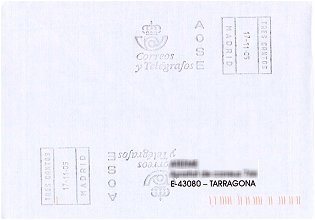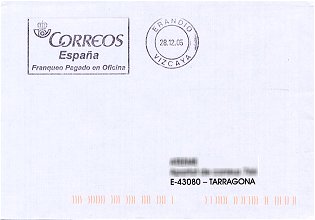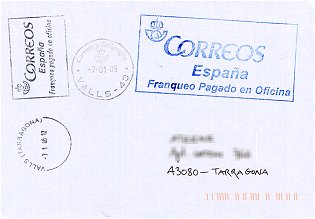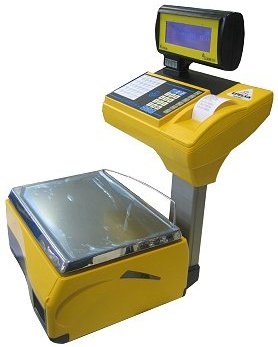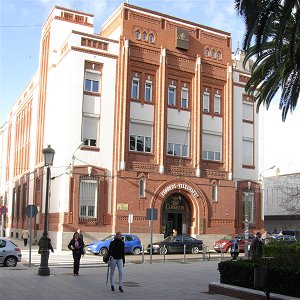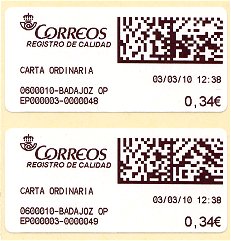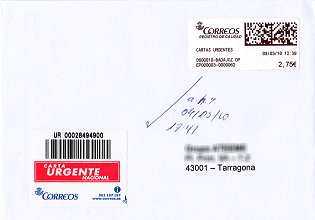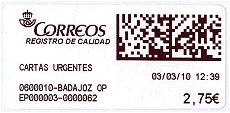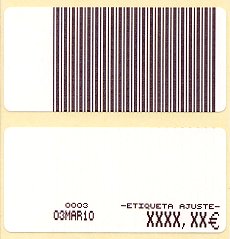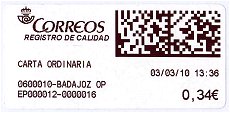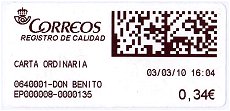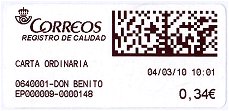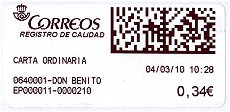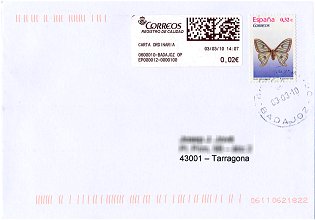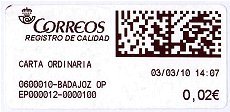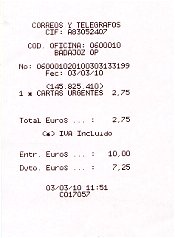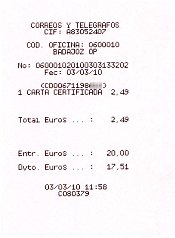After using different types of ATMs and variable value stamps, for more than 25 years, the Spanish Post - Correos, in late 2006, started to withdraw variable value stamps as a means of franking items which had been handed in at major post offices that were connected to the Iris postal network throughout the country.
The second phase of this test was extended during December 2005 to 30 other post offices throughout the country. The criteria and internal operations in the post offices were identical to the previous experience, although in this second phase the admission of international mail items was allowed, and the postal mark printed on the letters was changed with the introduction of the text Franqueo pagado en oficina (Postage paid at post office). (For more information, read article: The new ‘Postage Paid’ impression at the Spanish Post Offices, also published in VARIABLE 2. Others articles, only Spanish version: Pruebas para un nuevo sistema de admisión de envíos - 1a. fase and 2a fase).
The last phase of this process began in November 2006. Province by province, new post offices were added to the new mail admission system. Following a remote access change in the software, the Iris application, supplemented by the manual adjustment in the Epelsa franking scales to inhibit the stamp printer, resulted in all the post offices of the province, connected to the postal application of Correos, to stop the issue of stamps on the predetermined date. Since then the mail has been franked using a wide variety and range of Franqueo pagado en oficina (Postage Paid at post office) postal marks, applied using automated equipment and hand stamps. However, this change did not affect small post offices fitted with stand-alone franking scales, which have continued to issue variable value stamps, along with the (few) LF distributors still in service. But this admission system, extremely simple in concept, involved a serious problem with the lack of control on admission. Despite the more or less complex methods of supervision that some post offices had attempted to implement, the fact is that there was no method of controlling or verifying that the postage tariff had been paid, on any postal item brought to a post office, with no previous franking and entering the postal network. Any control is left to the goodwill of postal staff behind the counter. Put another way, an employee may accept postal items into the postal system without paying the postage. It is really surprising that one of the reasons, Correos argued, for the implementation of the mail admission system using Postage paid postal marks, was because of the lack of control in the variable value stamp (ATMs) issues, and instead they proposed another option whose main characteristic is precisely the absolute lack of control ... (Read also: The keys to understand the removal of ATMs at the Spanish post offices >, published in VARIABLE 3).
The reaction to this serious problem was swift. After studying various proposals, Correos launched a tender in September 2009 for the purchase of 69 peripheral scales connected to the Iris system. The big news was that these new scales should include, again, a label printer, and in the tender documents, in addition to the technical characteristics of the scales, there was also specified the characteristics of the new 'etiquetas', the new variable value stamps. The objective was to regain control. The tender was awarded in December 2009 to the Spanish company Grupo Epelsa S.L., manufacturer of all scales and weighing equipment currently used by Correos.
According to the tender specifications, the new balances have to issue 57 mm. wide variable value stamps, including all information on the postage stamp, plus a two-dimensional matrix barcode or Data matrix. The scales also must have the ability to print labels with code 128. The high resolution imprint is of a good quality.
The 2D Data matrix code, similar to the code printed by the digital franking machines *, is made up of 2 arrays of dots and all the information of the stamp is repeat in encrypted format. (* More information on digital franking, see article >>>, also published in VARIABLE 8).
While the system has been adequately tested experimentally, Correos decided to run a trial in post offices, in order to evaluate, in a real environment, the smooth running of the new DLT-ARM scales, as the new mail admission and franking system using variable value stamps.
All the scales installed in both post offices were replaced on March 2nd 2010 by the new Epelsa DLT-ARM, and the pilot test began on March 3rd, with the issue of the first variable value stamps.
The Epelsa DLT-ARM scales installed in the Don Benito post office are numbered EP000008, EP000009, and EP000011.
While new Epelsa DLT-ARM balances are fully compatible with all the current scales in service, because of their ability to issue variable value stamps, Correos will probably decide to install the 69 machines in a few post offices, removing the previous scales and filling up the equipment with the new ones, without mixing with other models. (To be continued ...) Notes. This article will be also published in the April issue of our quarterly publication (VARIABLE 16). A personal first day cover of this issue was mailed to all ATEEME members.
© J. Jove - M. Sans. ATEEME. Variable value stamps study group. All rights reserved This page was created in March 8th 2010, and last updated: 12.03.10 . English edition rewritten by S. Goodman (12.3.2010) |
|||||||||||||||||||||||||||||||||||||||||
